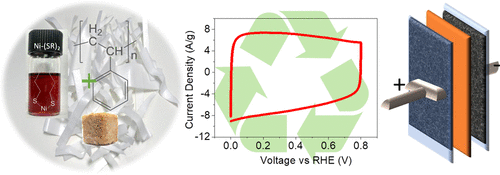当前位置:
X-MOL 学术
›
ACS Appl. Electron. Mater.
›
论文详情
Our official English website, www.x-mol.net, welcomes your
feedback! (Note: you will need to create a separate account there.)
Ni Ink-Catalyzed Conversion of a Waste Polystyrene–Sugar Composite to Graphitic Carbon for Electric Double-Layer Supercapacitors
ACS Applied Electronic Materials ( IF 4.3 ) Pub Date : 2020-09-07 , DOI: 10.1021/acsaelm.0c00542 Ajay B. Urgunde 1 , Gaurav Bahuguna 1 , Anandita Dhamija 1 , Parijat P. Das 1 , Ritu Gupta 1
ACS Applied Electronic Materials ( IF 4.3 ) Pub Date : 2020-09-07 , DOI: 10.1021/acsaelm.0c00542 Ajay B. Urgunde 1 , Gaurav Bahuguna 1 , Anandita Dhamija 1 , Parijat P. Das 1 , Ritu Gupta 1
Affiliation

|
The disposal of organic waste materials such as polymers is a serious problem to natural ecosystems as some of them can be non-biodegradable and potentially toxic. Thus, there is immense interest in developing processes that convert waste polystyrene into useable carbon. In this work, we developed a unique approach for obtaining graphitic carbon from waste polystyrene as a raw carbon source. The conversion process is catalyzed using the Ni-butanethiolate ink in ultralow quantities under an optimized temperature (800 °C) in the presence of 5% hydrogen in nitrogen. Interestingly, macroporous sugar cubes are used as a soft template to hold polystyrene and the catalyst together during decomposition, eliminating the need for a high-pressure source for retaining carbon for graphitization at high temperatures. An additional step of hydrogen annealing for pyrolyzed carbon nullifies the surface effects and improves the graphitization, reduces the point defects, and enhances the crystallinity of carbon and electrical conductivity specifically required for an electric double-layer capacitor (EDLC). The SPC8H-based graphitic carbon electrode exhibits perfect rectangular cyclic voltammetry characteristics with a symmetric triangular charge–discharge curve and a specific capacitance of ∼158 F/g at 1 A/g. The two-electrode EDLC device demonstrated excellent cyclic stability with a capacitance retention of ∼90% even after 10,000 cycles. This study reveals that the trashed polystyrene waste could be transformed into highly crystalline, graphitic carbon electrodes for energy storage devices. This indeed offers an alternative and sustainable approach with a low price to high-performance ratio that can probably manage the issue of white pollution at a commercial scale.
中文翻译:

Ni油墨催化的双层聚乙烯超级电容器废聚苯乙烯-糖复合材料转化为石墨碳
诸如聚合物之类的有机废料的处置对于自然生态系统是一个严重的问题,因为其中一些可能是不可生物降解的并且可能具有毒性。因此,人们对开发将废聚苯乙烯转化为可用碳的方法有极大的兴趣。在这项工作中,我们开发了一种独特的方法,可以从废弃的聚苯乙烯中获取石墨碳作为原始碳源。在最佳温度(800℃)下,在氮气中存在5%氢的情况下,使用超低含量的Ni-butanethiolate油墨催化转化过程。有趣的是,大孔方糖被用作软模板,以在分解过程中将聚苯乙烯和催化剂保持在一起,从而无需高压源来保留碳以在高温下进行石墨化。对热解碳进行氢退火的附加步骤消除了表面效应,改善了石墨化作用,减少了点缺陷,并增强了碳的结晶度和双电层电容器(EDLC)特有的导电性。基于SPC8H的石墨碳电极表现出完美的矩形循环伏安特性,具有对称的三角形充放电曲线,在1 A / g时的比电容约为158 F / g。两电极EDLC器件表现出出色的循环稳定性,即使经过10,000次循环,电容保持率仍约为90%。这项研究表明,废弃的聚苯乙烯废料可以转化为用于储能设备的高度结晶的石墨碳电极。
更新日期:2020-10-28
中文翻译:

Ni油墨催化的双层聚乙烯超级电容器废聚苯乙烯-糖复合材料转化为石墨碳
诸如聚合物之类的有机废料的处置对于自然生态系统是一个严重的问题,因为其中一些可能是不可生物降解的并且可能具有毒性。因此,人们对开发将废聚苯乙烯转化为可用碳的方法有极大的兴趣。在这项工作中,我们开发了一种独特的方法,可以从废弃的聚苯乙烯中获取石墨碳作为原始碳源。在最佳温度(800℃)下,在氮气中存在5%氢的情况下,使用超低含量的Ni-butanethiolate油墨催化转化过程。有趣的是,大孔方糖被用作软模板,以在分解过程中将聚苯乙烯和催化剂保持在一起,从而无需高压源来保留碳以在高温下进行石墨化。对热解碳进行氢退火的附加步骤消除了表面效应,改善了石墨化作用,减少了点缺陷,并增强了碳的结晶度和双电层电容器(EDLC)特有的导电性。基于SPC8H的石墨碳电极表现出完美的矩形循环伏安特性,具有对称的三角形充放电曲线,在1 A / g时的比电容约为158 F / g。两电极EDLC器件表现出出色的循环稳定性,即使经过10,000次循环,电容保持率仍约为90%。这项研究表明,废弃的聚苯乙烯废料可以转化为用于储能设备的高度结晶的石墨碳电极。











































 京公网安备 11010802027423号
京公网安备 11010802027423号